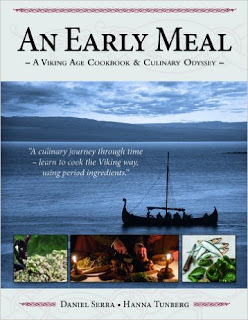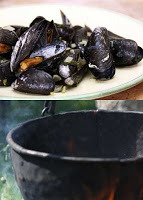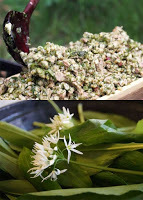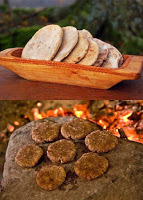Cook Like a Viking
 What did the Vikings eat? We imagine them gorging on roast leg of lamb and buckets of ale. In Valhalla, according to Snorri Sturluson, the heroes eat boiled pork and drink bottomless horns of mead. When Odin and Loki dine out, in one myth, they spit-roast an ox (though Odin is said elsewhere to subsist only on wine).
What did the Vikings eat? We imagine them gorging on roast leg of lamb and buckets of ale. In Valhalla, according to Snorri Sturluson, the heroes eat boiled pork and drink bottomless horns of mead. When Odin and Loki dine out, in one myth, they spit-roast an ox (though Odin is said elsewhere to subsist only on wine).But is all that meat and alcohol realistic?
Daniel Serra, one of the authors (with Hanna Tunberg) of An Early Meal: A Viking Cookbook & Culinary Odyssey, thinks not.
Serra is an archaeology student--the book is based on his Ph.D. dissertation--and a Viking re-enactor who was hired to "reconstruct Viking Age food" by the Lofotr Viking Museum in Lofoten, site of the largest Viking longhouse ever discovered, in the far north of Norway.
There's nothing like having to actually do it to make you figure out how something was done.
His book concentrates on Norway, Denmark, and Sweden. Beginning at Lofoten, he takes the reader (or cook) on a "culinary odyssey," sailing to important archaeological sites at Kaupang, Lejre, Hedeby, Uppåkra, and Birka, with a side trip to Jorvik in England. For each site, he describes the archaeological evidence for what people in Viking times ate and how they prepared it.
We can learn a lot from bones, seeds, utensils, pots, and, yes, feces.
Serra also explores the Icelandic sagas and other post-Viking Age written sources for hints on food and cooking, such as the stories of yogurt-like skyr being stored in leather bags, vats of whey big enough for a man to hide in, cheeses made in round cheese forms, porridge served with a large ladle, and leek or onion soup fed to a wounded man to determine (by the smell) if his intestines had been pierced.
 Serra and Tunberg then create a few recipes that plausibly could be connected with each archaeological site, being careful to only mix foods that were available and in season. This is the ultimate in seasonal, locavore cooking--with a very few luxury items thrown in, where the archaeological record warrants it.
Serra and Tunberg then create a few recipes that plausibly could be connected with each archaeological site, being careful to only mix foods that were available and in season. This is the ultimate in seasonal, locavore cooking--with a very few luxury items thrown in, where the archaeological record warrants it.Don't expect a lot of spice. The Vikings used mustard seeds (both black and yellow), thyme, dill, caraway, coriander, and lots of onions, leeks, and garlic. Salt was expensive to buy or, if home-made (by burning seaweed), labor-intensive and inefficient to make.
Sweets were scarce: The main sources were dried or frost-bitten berries and fruits, honey (expensive, as bees could only survive in some parts of Scandinavia), and malt (which was mostly used for making ale).
The most common taste was sour: Turnips and kale, as well as sausages and joints of meat, were pickled in whey, the leftover fluid from cheese-making. Whey was also the drink of choice, when ale wasn't available--and sometimes the two were mixed (ugh).
And that roast leg of lamb? It was more likely to be smoked or dried, then cut up and cooked as a stew with onions and turnips.
Valhalla's boiled pork doesn't sound nearly so tasteless, though, when you read Serra and Tunberg's recipe for Boar Stew: It contains leeks, butter, bacon, boar's meat, mustard, kale, wheat seeds, and thyme, along with the boiled pork. The photograph makes it look actually appetizing.
 The recipes throughout An Early Meal are, in fact, beautifully illustrated. The instructions are clear and easy--according to my friend Linda, an excellent cook who reads cookbooks for pleasure--and the book's paper and binding are sturdy enough to survive heavy kitchen use.
The recipes throughout An Early Meal are, in fact, beautifully illustrated. The instructions are clear and easy--according to my friend Linda, an excellent cook who reads cookbooks for pleasure--and the book's paper and binding are sturdy enough to survive heavy kitchen use.Still, I only found a few meals I'd want to try. (Linda, more adventurous in her eating, found more.) For me, the value of the book is for re-enacting--in fiction--what Viking life was really like.
I learned, for instance, how to make a cooking pit to roast a goat. Did you know that you should put the layer of stones under the firewood if you plan to use the pit more than once, but lay them over the firewood if the ground is cold? And how do you keep the meat from charring? Serra suggests several medieval replacements for aluminum foil.
Did you know that to make dried cod tasty, you should beat it with a wooden mallet for "well over an hour," then soak it in hot water for at least 12 hours?
Or that Vikings ate lots of hazelnuts? Mixed with honey, says a medieval Scandinavian herbal, they are good for a cough.
Or that the best way to cook the mash and boil the wort, when making large quantities of ale, was to heat stones in the longfire, then drop them one by one into a large tub of mash or wort until it reached the required temperature? (Your thermometer in this case was your finger.) If making a smaller quantity of ale, you use smaller tubs and smaller stones--these stones are called "pot-boilers." How often have I used that term to refer to a formulaic mystery novel without knowing what it really meant?
 Then there's the question of bread. I knew grain was hard to grown in Iceland, but I assumed bread was common throughout the rest of Scandinavia. Archaeologists have found signs of bread in burials and funeral pyres. They could tell it was unleavened, cooked on a griddle or a hot stone (rarely baked in an oven), and made of some mixture, depending on the location, of barley, oats, wheat, rye, pea, and broad-bean flours.
Then there's the question of bread. I knew grain was hard to grown in Iceland, but I assumed bread was common throughout the rest of Scandinavia. Archaeologists have found signs of bread in burials and funeral pyres. They could tell it was unleavened, cooked on a griddle or a hot stone (rarely baked in an oven), and made of some mixture, depending on the location, of barley, oats, wheat, rye, pea, and broad-bean flours.I never gave a thought to how hard it was to grind the flour. That's why I love experimental archaeology. When Daniel Serra made bread at the Lofotr Viking Museum, he started with grain (seeds) and a hand quern.
He describes the quern as "two stone discs on top of each other." The stone is mica-schist with small hard garnets in it. The larger stone, on the bottom, "is fixed by nothing else but its weight." The upper stone has a handle; sometimes that handle extends to the roof of the building to get better torque. "In order to get the best result," Serra writes, "the cereals must be fed to the quern constantly so that friction is kept low and the two discs suffer less wear."
And you don't just feed the cereals in once. "Grinding with a hand quern is hard work." In his experiment, Serra ground half a kilogram (18 ounces) of grain; a bread recipe he includes in An Early Meal uses about that much barley flour for a loaf meant to feed four (modern) people as part of a larger meal.
"The experiment showed that the seeds had to be ground several times and sieved in order to achieve a flour that was fine enough with which to bake. After two grindings, the grains were fine enough to be used for a porridge. After another four or five more sessions, and half an hour, the seeds were fine enough to bake with. With experience and the right conditions, the time could probably be halved. The time and effort needed suggests that one would produce only enough flour to cover the needs of the day."
 Making flour for bread "was a rather strenuous activity," he concludes, adding that "Milling seems to have been mainly considered a female chore, and some skeletal remains have a tear in the shoulder joints which may stem from constantly working with a hand quern."
Making flour for bread "was a rather strenuous activity," he concludes, adding that "Milling seems to have been mainly considered a female chore, and some skeletal remains have a tear in the shoulder joints which may stem from constantly working with a hand quern."Don't assume, though, that Viking women did all the cooking. "In Norwegian burials," Serra points out, "certain cooking implements have been almost equally distributed between men and women--e.g., frying pans, spits, and soapstone vessels."
It's for these sorts of insight that An Early Meal deserves a spot on your bookshelf.
An Early Meal: A Viking Age Cookbook and Culinary Odyssey, by Daniel Serra and Hanna Tunberg, was published in Sweden in 2013 by ChronoCopia Publishing. I purchased my copy over Amazon.com.
For more about food in Norse mythology, see these earlier blog posts:
http://nancymariebrown.blogspot.com/2015/12/did-viking-greenland-collapse.html
http://nancymariebrown.blogspot.com/2013/01/seven-norse-myths-we-wouldnt-have_16.html
For more on Snorri Sturluson and the making of Norse mythology, see my book Song of the Vikings: https://www.nasw.org/users/nmb/books.html#SV
Published on March 09, 2016 06:58
No comments have been added yet.



